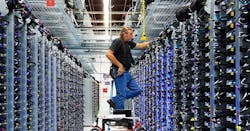As it expands its massive data center network, Google is focusing a large chunk of its computing power in the Southeastern United States, a data center site selection strategy that is unique among cloud-scale operators.
The strategy appears to be driven by the region’s attractive economics and Google’s interest in retooling existing power-intensive industrial infrastructure. A secondary factor is proximity to U.S. population centers, which are heavily focused on the Eastern half of the country.
Last month Google said it will build a $600 million data center in a former semiconductor fabrication plant in Clarksville, Tennessee. That follows the company’s June 2015 announcement that it will invest $600 million to convert a former coal plant in Jackson County, Alabama into a new data center.
As the pioneer in the hyperscale data center business, Google has been the pacesetter in building its own servers, switches and data centers. Its server farm in Oregon was the first of the major cloud campuses, and the company’s site selection strategy has been a guide to the best places in the world to build a data center.
This raises a question: Is Google’s focus on the Southeast a leading indicator of future data center development in the region? Or is it simply a case of a savvy player unearthing unique retrofit opportunities that may not work for other cloud builders?
The Blueprint: Regional Cloud Hubs
Hyperscale companies like Google must serve data to hundreds of millions of users around the world, and the placement of data centers is critical to supporting this growth. The prevailing hyperscale model employs large data center hubs, typically focused in three regions – one on the East Coast, one on the West Coast, and one in the center of the country. This market coverage ensures good latency on traffic to most U.S. destinations, with the coastal data hubs also serving traffic to Europe and Asia.
The originator of this model was Google, which in 2006 and 2007 began building data centers focused on the East Coast (North and South Carolina), Midwest (Iowa and Oklahoma) and West Coast (Oregon). Versions of this model have been deployed by Facebook, Apple, Microsoft and Amazon Web Services.
As Google grows beyond its initial data center footprint, it has focused its expansion on the southeast. Google has existing data centers in North Carolina, South Carolina and Georgia, so the new projects place five of its eight company-built U.S. computing campuses in the South. Here’s a look at Google’s footprint for company-built data centers in the United States:
The data center industry is known for clustering behavior, with concentrations of data centers in key markets. This occurs due to the alignment of several factors:
- Access to Customers: It’s not an accident that major data centers cluster around large metros like New York, Chicago and Los Angeles. Companies in the financial and entertainment industries need processing power, while service providers seek a critical mass of customers.
- Access to Networks: Data centers gravitate to Internet intersections where they can connect with major networks and partners. This trend is seen in clusters in Ashburn, Virginia and Silicon Valley.
- Access to Cheap Power: The development of massive server farms led hyperscale companies to seek out rural areas offering a combination of cheap land and cheap power. This has been a driving force in the evolution of clusters in central Washington, Oregon, Iowa and North Carolina.
Google was a significant first-mover in clusters in Oregon and North Carolina, two states where it has been followed by projects from Apple and Facebook. In those cases, Google clearly identified favorable site selection criteria, which proved attractive to others in the industry. But there are also several markets – notably Charleston, South Carolina and Pryor, Oklahoma – where Google remains the only hyperscale player in town.
Google’s Site Selection Process
The data center site selection process can identify ideal locations to save money on power, cooling and land, as well as areas where economic incentives can reduce the taxes a company will pay on the hundreds of millions of dollars it may spend on servers, storage and power equipment.
A backup tape library inside a Google data center near Charleston, South Carolina. (Photo: Google)
Google says its site selection team considers a large number of variables. Geographic diversification is a big one. For risk management reasons, Google likes to maintain a certain distance between its data centers, so a single regional disaster won’t impact more than one facility.
“We have a very rigorous process that we use to select sites, which includes, among other factors, a combination of location, available land, existing infrastructure, access to renewable energy sources and electrical infrastructure, and a community that’s excited to work with us,” said a Google spokesperson. “When selecting any site, we look at the unique attributes and base our designs around them to build the most efficient and high-performing data centers possible.”
A major factor in recent decisions has been the availability of existing power infrastructure. For example, the new site in Tennessee is a former semiconductor manufacturing plant, a retrofit path that is proving popular to data center developers (see Intel Data Center Design Reaches New Height of Efficiency).
“This site comes with the benefits of existing infrastructure, which we plan to reuse and recycle – for example, many of the office buildings will be used for Googlers when the data center is operational,” said Joe Kava, Vice President for Data Center Operations at Google. “At the same time, we have room to innovate and grow both as a data center and as a member of the Montgomery County community. We’re excited about the opportunity to experiment with new kinds of technology and design an impressive facility.”
Google’s site in Widows Creek, Alabama is a former coal power plant operated by the Tennessee Valley Authority, which creates some interesting possibilities in energy procurement.
“At Widows Creek, we can use the plants’ many electric transmission lines to bring in lots of renewable energy to power our new data center,” said Patrick Gammons, Senior Manager of Data Center Energy and Location Strategy at Google. “Thanks to an arrangement with Tennessee Valley Authority, our electric utility, we’ll be able to scout new renewable energy projects and work with TVA to bring the power onto their electrical grid. Ultimately, this contributes to our goal of being powered by 100 percent renewable energy.”
Thinking Regionally
Google is unique in its focus on the southeast, but it’s not the only huge data center player to focus its infrastructure in a particular region. eBay houses its U.S. data center infrastructure in the Southwest, with facilities in Phoenix, Las Vegas and West Jordan, Utah, with another site currently under construction in Reno, Nevada.
Does Google have different site selection criteria than other cloud-scale players? Or is it simply ahead of its time in choosing markets like South Carolina, Tennessee and northern Alabama? To a large degree, Google’s Southeastern projects are opportunistic purchases of distressed properties with great power infrastructure, allowing Google to operate with a low cost structure. Some of the largest Internet players have the resources to pursue these type of retrofits, but most prefer a ground-up “greenfield” build that allows them to customize every element of the data center. Google does greenfield builds in some markets, and retrofits in others.
Ultimately, data centers will follow the eyeballs, and be placed in proximity to the end users they serve. That favors locating data centers in the Eastern U.S., as about 58 percent of the U.S. population resides east of the Mississippi River. The country’s population density is reflected by this night-time satellite image.
This satellite image of the U.S. at night illustrates the concentration of population in the eastern half of the country. (Photo: NOAA)
As Google fills in its infrastructure map, it makes sense to focus on the eastern U.S. The concentration of infrastructure in the southeast is clearly sufficient to serve Internet traffic to the huge mass of users in the Northeast corridor – which is one of the most expensive regions to build and operate a data center. Building that capacity in the Southeast is cheaper.
Capacity planning is one of the toughest challenges in the data center business. Creating regional data center hubs allows cloud-scale companies to rapidly add server capacity and electric power, creating economies of scale as more workloads migrate into these massive server farms.
As Internet audiences grow into the billions, content providers have focused on edge computing, building smaller data centers in local markets to accelerate the delivery of videos and applications. In a discussion with Data Center Frontier last year, Kava said he expects that Google’s data center strategy will remain focused on large regional cloud campuses, but the company can adapt quickly to user requirements.
“The campus model still makes a lot of sense,” said Kava. “But we may have to eventually have a more distributed approach. You’re going to have to have more edge cache nodes. It won’t replace the campus system, but we might see more of that. We have to be prepared to react to the business imperatives.”
About the Author



